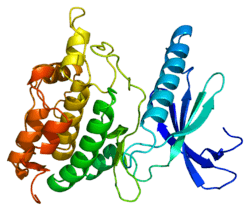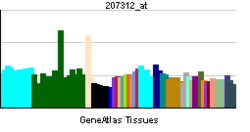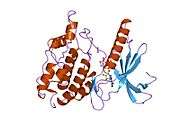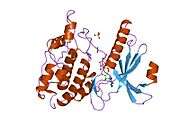PHKG1
Phosphorylase b kinase gamma catalytic chain, skeletal muscle isoform is an enzyme that in humans is encoded by the PHKG1 gene.[3][4]
This gene is a member of the Ser/Thr protein kinase family and encodes a protein with one protein kinase domain and two calmodulin-binding domains. This protein is the catalytic member of a 16 subunit protein kinase complex which contains equimolar ratios of 4 subunit types. The complex is a crucial glycogenolytic regulatory enzyme. This gene has two pseudogenes at chromosome 7q11.21 and one at chromosome 11p11.12.[4]
References
Further reading
- Jones TA, da Cruz e Silva EF, Spurr NK, et al. (1990). "Localisation of the gene encoding the catalytic gamma subunit of phosphorylase kinase to human chromosome bands 7p12-q21". Biochim. Biophys. Acta. 1048 (1): 24–9. doi:10.1016/0167-4781(90)90017-V. PMID 2297530.
- Harris WR, Malencik DA, Johnson CM, et al. (1990). "Purification and characterization of catalytic fragments of phosphorylase kinase gamma subunit missing a calmodulin-binding domain". J. Biol. Chem. 265 (20): 11740–5. PMID 2365696.
- Dasgupta M, Honeycutt T, Blumenthal DK (1989). "The gamma-subunit of skeletal muscle phosphorylase kinase contains two noncontiguous domains that act in concert to bind calmodulin". J. Biol. Chem. 264 (29): 17156–63. PMID 2507540.
- Drewes G, Trinczek B, Illenberger S, et al. (1995). "Microtubule-associated protein/microtubule affinity-regulating kinase (p110mark). A novel protein kinase that regulates tau-microtubule interactions and dynamic instability by phosphorylation at the Alzheimer-specific site serine 262". J. Biol. Chem. 270 (13): 7679–88. doi:10.1074/jbc.270.13.7679. PMID 7706316.
- Wehner M, Clemens PR, Engel AG, Kilimann MW (1995). "Human muscle glycogenosis due to phosphorylase kinase deficiency associated with a nonsense mutation in the muscle isoform of the alpha subunit". Hum. Mol. Genet. 3 (11): 1983–7. doi:10.1093/hmg/3.11.1983. PMID 7874115.
- Yuan CJ, Huang CY, Graves DJ (1994). "Oxidation and site-directed mutagenesis of the sulfhydryl groups of a truncated gamma catalytic subunit of phosphorylase kinase. Functional and structural effects". J. Biol. Chem. 269 (39): 24367–73. PMID 7929096.
- Malencik DA, Zhao Z, Anderson SR (1994). "Preparation and functional characterization of a catalytically active fragment of phosphorylase kinase". Mol. Cell. Biochem. 127-128: 31–43. doi:10.1007/BF01076755. PMID 7935360.
- Steiner RF, Juminaga D, Albaugh S, Washington H (1996). "A comparison of the properties of the binary and ternary complexes formed by calmodulin and troponin C with two regulatory peptides of phosphorylase kinase". Biophys. Chem. 59 (3): 277–88. doi:10.1016/0301-4622(95)00125-5. PMID 8672716.
- Paudel HK (1997). "The regulatory Ser262 of microtubule-associated protein tau is phosphorylated by phosphorylase kinase". J. Biol. Chem. 272 (3): 1777–85. doi:10.1074/jbc.272.3.1777. PMID 8999860.
- Lowe ED, Noble ME, Skamnaki VT, et al. (1998). "The crystal structure of a phosphorylase kinase peptide substrate complex: kinase substrate recognition". EMBO J. 16 (22): 6646–58. doi:10.1093/emboj/16.22.6646. PMC 1170269
 . PMID 9362479.
. PMID 9362479.
- Sengupta A, Kabat J, Novak M, et al. (1998). "Phosphorylation of tau at both Thr 231 and Ser 262 is required for maximal inhibition of its binding to microtubules". Arch. Biochem. Biophys. 357 (2): 299–309. doi:10.1006/abbi.1998.0813. PMID 9735171.
- Wang JZ, Wu Q, Smith A, et al. (1998). "Tau is phosphorylated by GSK-3 at several sites found in Alzheimer disease and its biological activity markedly inhibited only after it is prephosphorylated by A-kinase". FEBS Lett. 436 (1): 28–34. doi:10.1016/S0014-5793(98)01090-4. PMID 9771888.
- Hanger DP, Betts JC, Loviny TL, et al. (1998). "New phosphorylation sites identified in hyperphosphorylated tau (paired helical filament-tau) from Alzheimer's disease brain using nanoelectrospray mass spectrometry". J. Neurochem. 71 (6): 2465–76. doi:10.1046/j.1471-4159.1998.71062465.x. PMID 9832145.
- Schneider A, Biernat J, von Bergen M, et al. (1999). "Phosphorylation that detaches tau protein from microtubules (Ser262, Ser214) also protects it against aggregation into Alzheimer paired helical filaments". Biochemistry. 38 (12): 3549–58. doi:10.1021/bi981874p. PMID 10090741.
- Reynolds CH, Betts JC, Blackstock WP, et al. (2000). "Phosphorylation sites on tau identified by nanoelectrospray mass spectrometry: differences in vitro between the mitogen-activated protein kinases ERK2, c-Jun N-terminal kinase and P38, and glycogen synthase kinase-3beta". J. Neurochem. 74 (4): 1587–95. doi:10.1046/j.1471-4159.2000.0741587.x. PMID 10737616.
- Liu F, Iqbal K, Grundke-Iqbal I, Gong CX (2002). "Involvement of aberrant glycosylation in phosphorylation of tau by cdk5 and GSK-3beta". FEBS Lett. 530 (1–3): 209–14. doi:10.1016/S0014-5793(02)03487-7. PMID 12387894.
- Strausberg RL, Feingold EA, Grouse LH, et al. (2003). "Generation and initial analysis of more than 15,000 full-length human and mouse cDNA sequences". Proc. Natl. Acad. Sci. U.S.A. 99 (26): 16899–903. doi:10.1073/pnas.242603899. PMC 139241
 . PMID 12477932.
. PMID 12477932.
- Gevaert K, Goethals M, Martens L, et al. (2004). "Exploring proteomes and analyzing protein processing by mass spectrometric identification of sorted N-terminal peptides". Nat. Biotechnol. 21 (5): 566–9. doi:10.1038/nbt810. PMID 12665801.
- Burwinkel B, Hu B, Schroers A, et al. (2004). "Muscle glycogenosis with low phosphorylase kinase activity: mutations in PHKA1, PHKG1 or six other candidate genes explain only a minority of cases". Eur. J. Hum. Genet. 11 (7): 516–26. doi:10.1038/sj.ejhg.5200996. PMID 12825073.
PDB gallery |
|---|
|
| 1phk: TWO STRUCTURES OF THE CATALYTIC DOMAIN OF PHOSPHORYLASE, KINASE: AN ACTIVE PROTEIN KINASE COMPLEXED WITH NUCLEOTIDE, SUBSTRATE-ANALOGUE AND PRODUCT |
| 1ql6: THE CATALYTIC MECHANISM OF PHOSPHORYLASE KINASE PROBED BY MUTATIONAL STUDIES |
| 2phk: THE CRYSTAL STRUCTURE OF A PHOSPHORYLASE KINASE PEPTIDE SUBSTRATE COMPLEX: KINASE SUBSTRATE RECOGNITION |
|
|
|
|---|
|
| Activity | |
|---|
|
| Regulation | |
|---|
|
| Classification | |
|---|
|
| Types | |
|---|


 . PMID 9362479.
. PMID 9362479. . PMID 12477932.
. PMID 12477932.

